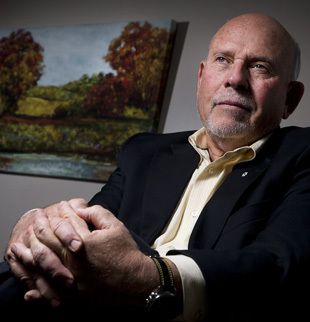
Burnout
The Psychic Perils of Forensic Practice
Exposure to horror can cause vicarious traumatization, professional burnout
Posted December 12, 2013
John Bradford burst into tears. Hitting the road for the four-hour trek back to his home in Ontario, Canada, he could not stop crying and shaking.
John Bradford, forensic psychiatristAn internationally renowned forensic psychiatrist, Bradford had been working around-the-clock on the high-profile case of Canadian Air Force Colonel Russell Williams, a decorated military pilot and commander of the country's largest military airbase who had spent his spare time torturing and murdering women.
Bradford's breakdown took him by surprise. Like other forensic practitioners, he had spent decades sitting across the table from rapists, murderers and sexual sadists. He was adept at emotionally distancing himself from their twisted psyches and wretched deeds. But the gruesome video of two young women screaming and begging for their lives (unsuccessfully, as he knew) proved a tipping point.
Descending into a very dark place, he was eventually diagnosed with posttraumatic stress disorder. He underwent lengthy therapy and drug treatment. Although he has now returned to his forensic practice, he is more cautious about the types of cases he will take on.
The profile by reporter Chris Cobb in the Ottawa Citizen, documenting Bradford's three-year struggle with vicarious traumatization, came as a complete shock to me. It was just three years ago that I served with Bradford on a team debating three controversial paraphilias being proposed for the DSM-5. Bradford, an advisor to the DSM-IV, was past president of the American Academy of Psychiatry and Law (AAPL), which hosted the debate. He holds numerous other accolades. He is a professor at the University of Ottawa, founder and clinical director of the Sexual Behaviors Clinic in Ottawa, and a Distinguished Fellow of the American Psychiatric Association, earning its prestigious Isaac Ray Award.
If he could fall apart, I wondered, who couldn’t?

Photo credit: Wayne Cuddington, Postmedia News
Bradford described for the reporter how his mental state gradually morphed from calm and collected to irritable and angry, as he worked long hours on the Williams case. At one point, being cross-examined by a defense attorney in another case, he got so irritated by the attorney’s repetitiousness that he almost blurted out, "Why don’t you shut the f-- up, you a—hole?' "
It was then that he realized he was losing control.
"I knew there was something wrong but there was a lot of denial on my part," the 66-year-old Bradford told Cobb. "And that’s why it didn’t work when I first went into treatment. I was pessimistic and depressed, but if you’re a psychiatrist and a tough forensic guy you think you can blow anything off, right? And that’s what I did."
I was struck by the courage it must have taken Bradford to reveal his vulnerabilities to the world. I hope that his personal story can help stimulate conversation on the emotional dangers of this work. If Bradford can crumble, so can anyone, no matter how experienced, competent, or externally cool. Being part of a culture in which weakness is taboo, and can even be professional suicide, makes honest disclosure and help-seeking all the more difficult.
Confronting vicarious traumatization
Vicarious traumatization (also known as compassion fatigue, secondary trauma, or just plain burnout) has received some attention in professional circles in the past few years. There are books, journal articles, professional trainings, even websites.

Williams' victims, Jessica Lloyd and Marie-France Comeau
The DSM-5 criteria for Posttraumatic Stress Disorder (PTSD) reflect this growing awareness. Criterion A, which lists the stressors that make one eligible for the diagnosis, now includes "experiencing repeated or extreme exposure to aversive details of the traumatic event(s)." To keep those who view disasters on TV from being diagnosed with PTSD, as happened after the 9/11 terrorist attack, the text clarifies that this applies to such people as "first responders collecting human remains or police officers repeatedly exposed to details of child abuse," and NOT to those exposed through the media, "unless this exposure is work related."
As this criterion implies, vicarious traumatization can strike not just forensic evaluators, but anyone who spends too much time rubbing up against trauma—nurses, ambulance operators, child welfare workers, police, lawyers, judges, even jurors.
Studies on its incidence among forensic professionals are mixed. An unpublished survey by graduate student Julie Brovko and forensic psychologist William Foote of the University of New Mexico found low levels of vicarious traumatization among a convenience sample of 65 forensic psychologists. However, consistent with Bradford's case, more time in the field was correlated with more problems.
In contrast, a 2010 survey of 52 Australian clinicians providing treatment to convicted sex offenders found no evidence of compassion fatigue or burnout. The majority reported low stress and high levels of job satisfaction working with this challenging population. Ruth Hatcher and Sarah Noakes found that supervision and external social support helped clinicians avoid burnout.
One limitation of both of these studies is that they surveyed only those who remained active in the field. Anecdotal accounts suggest that some individuals leave forensic practice due to the emotional toll, which can produce feelings of estrangement, numbness, and hypervigilance.
An opposite danger?
Reflecting on Bradford's breakdown, I thought about the opposite tendency. Is it resilience that keeps other professionals from crumbling under the weight of witnessing constant perversion and misery? Or, might some be repressing their feelings in a manner that is not so healthy?
After all, to not be disturbed by graphic cruelty or stark oppression is in itself disturbing. Such psychic numbing whittles away at one's humanity.
In the memoir 12 Years a Slave (which I highly recommend), Solomon Northrup reflected on how the cruelty of slavery fostered casual violence not only toward slaves but also among white slaveholders. These men thought nothing of stabbing or shooting each other at the slightest provocation, the Southern "culture of honor" that remains with us today:
"Daily witnesses of human suffering—listening to the agonizing screeches of the slave—beholding him writhing beneath the merciless lash … it cannot otherwise be expected, than that they should become brutified and reckless of human life."
I've seen that phenomenon first-hand in institutions. Brutality breeds brutality, along with an indifference to brutality among institutionalized professionals that is equally troubling.
Mitigation?
Perhaps the first step in addressing the problem is for professionals to openly discuss the risk of professional burnout, vicarious traumatization, and psychic numbing. It’s very useful to have support and consultation groups where one can let one's guard down and be more vulnerable, debriefing after horrific case work with trusted colleagues.
Mindful meditation is so en vogue these days that I hesitate to join the bandwagon, but I do think it too can help reduce stress and emotional meltdowns.
Balance is also essential. Rest, relaxation, hobbies, exercise. It's not coincidental that Bradford broke down while working around-the-clock on a high-profile case.
Bottom line: Beware the hazards of forensic work, and try to take proactive steps to stay emotionally healthy.



